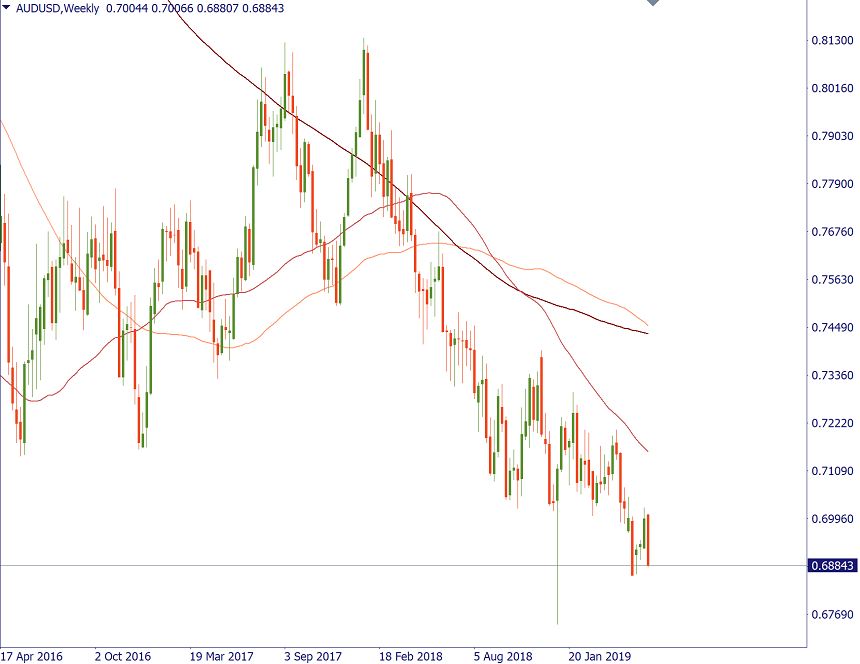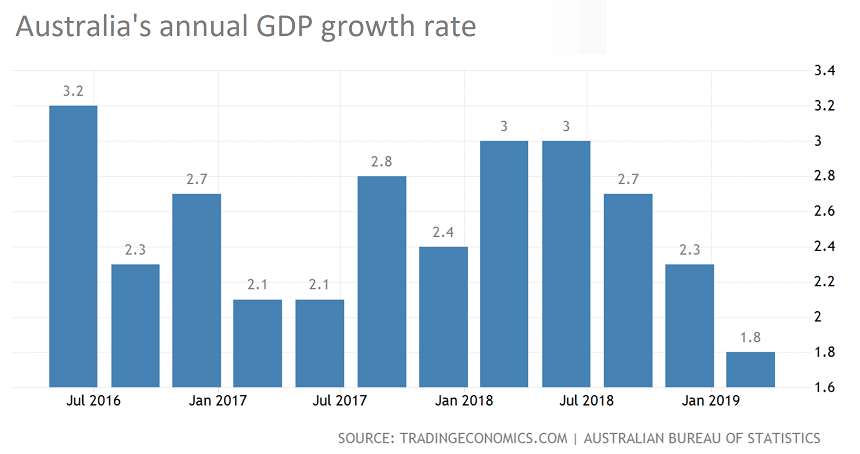
Dua tahun ini, kita menyaksikan pergerakan harga minyak terbesar dalam tempoh 14 tahun, yang membingungkan pasaran, pelabur dan pedagang akibat ketegangan geopolitik dan peralihan ke tenaga bersih.
2019-11-11 • Dikemaskini
The Australian dollar has been in a downtrend versus the greenback since the start of 2018.

Last year, the US currency strengthened against its Australian counterpart as the Federal Reserve was increasing the federal funds rate. The Reserve Bank of Australia had kept its Cash rate at 0.5% from August 2016 until June 5, 2019, when it reduced it to 1.25%. Since then, AUD/USD has once again turned down. Although the Fed has stopped rate hikes and the market now expects the US central bank to cut rates two times this year, the Aussie still keeps depreciating. It happens as traders think that the RBA will be more aggressive in its policy easing than the Fed.
According to bond futures, the probability of another 25-bps rate cut in Australia in July equals to 66%. If the RBA doesn’t make this move next month, market players are almost certain that it will happen in August.
Australian economy
Australian domestic figures are soft. The nation’s problems are serious: low wages, a housing slump and below-target inflation.
The RBA targets the unemployment rate of 4.5%, while the current level of the indicator is 5.2%. The annual GDP growth in Q1 fell to 1.8% (vs. 3.2% in the US), the lowest level since 2009. Retail sales contracted by 0.1% in April. Sales of new homes in Australia fell by 11.8% in April making the biggest decline since 2005. Private capital expenditure - a leading indicator of economic health - went down by 1.7% in the first 3 months of the year. Quarterly CPI growth slowed down from 0.5% in Q4 to 0.0% in Q1.

You can see that wherever we look, the picture is negative. That’s why analysts are so sure that the RBA will continue to cut rates.
AUD as a risky currency
The ongoing trade war between the United States and China is bad for the Australian currency. China is Australia's major trading partner and its well-being is very important for Australia's economy and, consequently, the AUD.
The future will be decided at the G20 summit that will take place on June 28-29. If the US President Donald Trump doesn’t find common grounds with the Chinese leader Xi Jinping, America will probably announce the next rounds off tariffs on $325 billion of imports from China. That will hurt the Asian economy and, consequently, the AUD.
Conclusion
The decline of the AUD won’t be very rapid as the USD will be weakened by the Fed. In addition, the price of iron ore, Australia’s biggest export, is quite resilient. However, only a real US-Sino trade deal is capable to reverse the downtrend in AUD/USD. Until that happens, the Aussie’s pullbacks to the upside will be temporary. Even if the Fed cuts its main rate, it will still be higher than that of Australia.

Dua tahun ini, kita menyaksikan pergerakan harga minyak terbesar dalam tempoh 14 tahun, yang membingungkan pasaran, pelabur dan pedagang akibat ketegangan geopolitik dan peralihan ke tenaga bersih.

Selepas beberapa bulan menerima tekanan dari Rumah Putih, Arab Saudi mengalah dan bersetuju untuk meningkatkan pengeluaran bersama dengan ahli-ahli OPEC+ yang lain.

Penghujung tahun semakin hampir Apakah yang akan dibawakan oleh 2021 kepada kita? Jom ketahui apakah jangkaan di fikiran bank-bank besar!

Fed mengumumkan pada hari Rabu bahawa ia membiarkan kadar dasar tidak berubah pada 5…

Jepun melangkah lebih dekat kepada campur tangan mata wang dengan amaran terkuatnya apabila yen merosot ke paras paling lemah dalam kira-kira 34 tahun berbanding dolar…

Sentimen pasaran yang memulih pada pembukaan dagangan awal minggu semalam telah menukar semula haluan pergerakan USD…
FBS menyimpan rekod data anda untuk mengoperasikan laman web ini. Dengan menekan butang "Terima", anda menyetujui Polisi Privasi kami.
Permohonan anda telah diterima
Pengurus akan menghubungi anda dalam amsa terdekat
Permohonan panggil balik seterusnya untuk nombor telefon ini
boleh dilakukan dalam dalam
Jika anda mempunyai isu yang perlu disegerakan, sila hubungi kami menerusi
Live Chat
Masalah dalaman. Sila cuba sebentar lagi
Jangan bazir masa anda – pantau bagaimana NFP mempengaruhi dolar AS dan kaut keuntungan!
